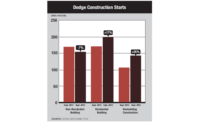"We try to be realistic about need," says Penny. "On most projects, we only put one up—although, on the George W. Bush Library, we had two because there were huge landscape features on a 23-acre site. As a builder, we don't necessarily need a Cadillac package.
"I don't know that the proximity of the vendor means anything for service in web-cams," Penny adds. "We interact with their office at a phone number. Service and how they accommodate our needs is more important."
For example, one of his clients wants a 60-minute delay and, if an accident were to happen, assurance that public streaming stops immediately.
Vendors say the drivers for the growing use include the rise of building information modeling and its increased need for accountability; as well as companies chasing work beyond usual areas of operations and needing to extend supervision while holding down travel of staffs trimmed by the recession.
"A lot of companies shrank. Those people went into other industries and haven't come back," says Chandler McCormick, president of Atlanta-based OxBlue, one of the two most widely known providers. "I've heard from clients that there is a gap in the [ranks of] middle management. The cameras give a better understanding of what's happening at the jobsite and lets more experienced personnel keep an eye on [more] projects. They use it as a training tool for new hires."
The picture is clouded, though, by a bitter legal action under way since 2011 between EarthCam and OxBlue. Filing suit in U.S. District Court for the Northern District of Georgia, Atlanta Division, EarthCam sought a jury trial on civil and criminal complaints. The plaintiff claims that OxBlue executives and employees have conducted, since 2002, a campaign to steal EarthCam technology and intellectual property and damage its business. It seeks OxBlue's profits as well as damages. OxBlue denies the claims, asserting they are either untrue or un-actionable. Its motions to dismiss have been denied, however, and filings have been piling up as the case works forward.
But there are also innovations in the job-cam market. One Tennessee photo-grapher, Bruce Cain, a retired civil engineer, has developed a business called Elevated Lens. His system raises his laptop-manipulated professional camera as high as 65 ft on a truck-mounted telescoping boom. "It's a pneumatic mast with valves in the cab that you can turn on to raise or lower," he says. "The camera is connected to a computer, so I see what the camera sees. I can pan, tilt, zoom and set the f-stop and speed." He says he obtains the job-cam look of a site vista photo with an 18-mm-to-200-mm zoom lens; employing it on a regular schedule, he can create time-lapse sequences of progress. "This works so good for construction [because] I get the aerial perspective, but, unlike in an airplane, I am really close. I can take several shots and stitch them together—you can't do that with aerial photos." Cain charges $200 a visit and delivers up to 75 photos each time.
Also, an Australian firm, photo-Sentinal, has entered the field with a self-contained, weatherized, low-power, G3-communications-equipped housing to let any construction photographer offer job-cam-style services, especially time-lapse videos, using their own favorite camera.






Post a comment to this article
Report Abusive Comment